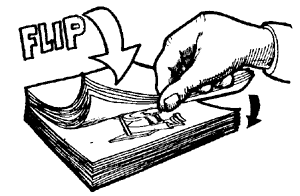
Drawing a moving picture book, or ‘flip-book’, seemed to be out of my grasp until I stumbled upon Robert Truscio’s tutorial. And all you need to make one is a pencil, a pad of paper, a little patience and Robert’s great advice.
First, Robert suggestions you choose a subject that lend themselves to movement, like animals and vehicles. He also says stick figures work well too.
Next, determine how the action, or the motion of your subject, will start and end. Robert reminds us that this might only take a few pages.
Robert suggests we draw our first and last pictures before we start. The action will begin at the bottom of the book and move to the top. Also, if your last drawing doesn’t match the top drawing, don’t worry. Just discard it.
For drawing those middle pages, Robert says to ‘draw or trace the next drawing on the next blank page on top of the drawing you just did. Work from the bottom page of the pad toward the top page. It is very helpful if the pad paper is thin enough to see through slightly. Then you can see the previous drawing. If not, you can flip the upper page every so often to compare the drawings.’ I could see where a light box might come in handy here.
When you’re done drawing, you can add color to your images.
As you flip your book from back to front, your image should appear as if it’s moving. Don’t worry if the motion is a little choppy. Robert says that determining how much movement you draw from page to page comes from practice. A great hint to remember is that the faster your object moves, the less drawings you’ll need, and the slower it moves, the more drawings you’ll need.
For complete illustrations, see Robert’s complete tutorial, and if you need a little inspiration, check out this very cool vid!